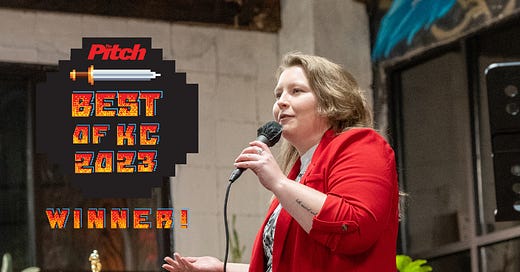Happy Friday y’all! I am humbled and honored to announce I won Best Poet/Spoken Word Artist in The Pitch’s 2023 Best of KC contest!
I deeply appreciate everyone who took the time to nominate me and vote. This is a super cool moment for me and I’m sure I’ll have more to say after I have time to reflect on it. The results were only announced this morning! I haven’t even put it on Instagram yet, so how do we know it’s real?
Meanwhile, I’ve been deep in the trenches working on new material, I’m doing a 30/30 writing challenge in November and writing a new piece/poem every day!
Relatedly, I’ve been thinking a lot about creativity and how to feel more creative. Here’s what I’ve come up with so far:
3 Ways to Stoke Your Creative Thinking When Writing
1. Write about what you have questions about, not just what you have answers for.
Some of you may be familiar with the saying “Write what you know.” And I’m not gonna knock that piece of advice, it can be useful in a lot of ways! However, part of being creative is about exploring new things. To be creative you need to be willing to explore the unknown.
You don’t need to be an expert to start writing on a topic. I am certainly not an expert on space or galaxies or even Godzilla, but these things show up in my writing all the time! You can always learn more about something, so you don’t have to know everything to start. I did a lot of research while I was writing my Godzilla show.
For most people, the idea of combining research and creative writing might not seem to make a lot of sense at first glance.
I think that’s rooted, partly, in the myth of “inspiration.” We often think of inspiration and creativity as mystical forces out of our control, but they’re not. More than that, creativity and inspiration are not the same thing.
Creativity is the ability to produce new ideas but also to recognize new associations between existing ideas.
Which leads me to my next point…
2. Embrace the rabbit hole, even if you don’t “use” the material.
Let yourself get a little lost in the rabbit hole, not everything you encounter needs to turn into something “useful” for your project. Exploring what interests us makes us whole and happy people. The idea that everything we learn needs to be “useful” is tied to the capitalist myth that we need to be productive to be worth anything.
And who knows, that random fact you find out about might come in handy some day. But the important part is to allow yourself to be open to new experiences regardless of how they might inform your creative practice.
3. Use constraints and exercises.
One of my favorite exercises recently has been using the writing workshops I’m a part of to shape something I’m already working on (my KC Fringe Show being a primary example this year). For a long time, I would always come to a writing workshop thinking I needed to use the prompts to create something new and out of nothing.
One of my favorite workshop instructors, Des, uses little brainstorms, also called “scaffolding” to help us get ready to write. We take time making lists and recalling memories before we start writing.
I’ve lately been taking it one step further. In one of the workshops I decided that no matter what the prompt was, I was going to write about Godzilla. Which meant I had to figure out how to work Godzilla into anything that could’ve been presented. This is the “making new associations” part of the creative practice.
Giving myself constraints has led to some of my favorite pieces that I’ve written this year, and also got me through some major blocks at times.





Congrats, Abby!